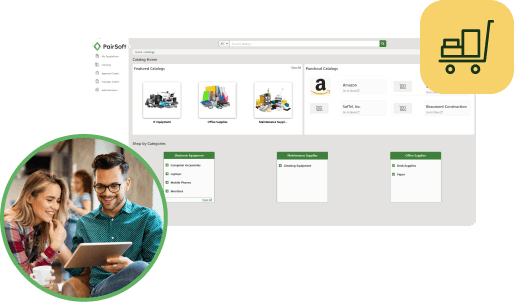
Janet Martin
Janet joined the PairSoft team upon its merger with Paramount Workplace, where she was also an integral part of the sales team for years. Janet resides in Michigan with her family.
View all posts by Janet MartinJanet Martin

While procurement scandals may not be as common as these infamous accounting scandals, mistakes and even malfeasance can and do happen.
Here we take a look at seven procurement mistakes—and how to avoid them.
An audit trail is essentially an entire history of a transaction—the who, what, and when of every interaction with the transaction.
One of the primary benefits of maintaining a procurement audit trail is to deter and detect potentially fraudulent activities. Think your small business is immune? A 2018 report by the Association of Certified Fraud Examiners found that the median business loss for businesses with fewer than 100 employees was $200,000, nearly double that of the $104,000 median loss reported for companies with 100 or more employees.
Data silos—discrete repositories of information under the control of one department and not shared with other departments—can hamper growth and efficiency in your business.
Data silos can result in duplication of efforts, bottlenecks, and missed opportunities. They typically occur not by design, but due to lack of integration between the software applications different departments rely on.
A purchase order is a great way to document an order with a supplier, but it cannot take the place of good communication. Supplier relationships are difficult to get right — research shows that fully half of supplier collaborations fail.
While almost one-third of companies surveyed in this 2018 Levvel Research study have an electronic budgeting tool in place, the majority of respondents either have a manual process or no process at all for monitoring procurement compliance against indirect spend budget.
So you’ve negotiated a competitive agreement with a new supplier that should save large sums of money on office supplies. Great!
Or is it?
That all depends on if the agreement is adhered to. Office supply spend is a classic example, as it is a very common place for this mistake to occur. You’ve worked to put together a competitively priced contract list of common items.
However, employees continue to order off-contract, bypassing all the work you’ve done—and end up purchasing supplies that are more expensive than the items you negotiated.
For most of us, negotiating is not a natural skill—but it’s a vital skill for procurement professionals. Negotiating the “right” deal with suppliers is not always as simple as obtaining the lowest price.
An article by Harvard Business Review offers up some simple, yet effective options for negotiating toward a win for all involved. One idea is to offer to bring new value to the relationship by introducing the supplier to new customers or markets.
A second idea is to offer to reduce the supplier’s risk by negotiating multi-year contracts at a set price point. And a third idea is to change how you buy, by centralizing procurement and consolidating purchase orders, thereby increasing your negotiating position and your buying power.
Deloitte’s Global Chief Procurement Officer Survey in 2018 found that just 33% of procurement leaders believe that their digital procurement strategy will enable them to deliver on their organizational objectives and value.
Procurement is one of the business functions that has the most to gain from technology, as it is traditionally one of the most paper-intensive and manual processes. One persuasive argument for automation lies in the potential savings organizations can achieve using a robust eProcurement solution.
A system that removes most (if not all) the manual touch points should be able to give you at least 50 to 60 to maybe 70% savings on the cost to process a purchase order or invoice. Calculate your potential savings here.
eProcurement applications are a practical way to reduce or even eliminate the common mistakes we’ve highlighted here. The software provides a robust audit trail and serves as a centralized database (especially when integrated with your company’s ERP).
It can incorporate budget controls and approval workflows, and guiding buying catalogs that enforce your policies. Convenient features for securing and tracking supplier contracts help ensure you’re maximizing their value.
Finally, eProcurement helps advance your organization’s digital procurement strategy, driving efficiency at every step of the procurement cycle.
Talk to an expert today to uncover how your team’s procurement stacks up against the top performers in your sector.



Many organizations start with manual receipt handling, fragmented card feeds and slow AP processes. Implement AI agents to auto-capture receipts, route approvals, enable punch-out buys and post to the ERP.
Result: faster batching, fewer errors and cost savings. “This saves us hours every month.”
Many organizations face slow, paper-heavy AP and fragmented procurement that waste time and inflate costs. AI Agents can automate approvals, PO matching and record sync to improve speed, accuracy and control. Client quote: “It freed up hours and made our process reliable.”
Operational drag and rising costs slow growth: teams waste time on manual tasks, misaligned priorities and opaque processes. AI Agents help automate routine work and coordinate actions across teams. “We’ve lost time to repeats and handoffs,” says a typical client.
Companies struggle with manual procurement, fragmented approvals, and costly integrations that slow growth and obscure spend. Our AI Agents streamline requisitions, POs, and invoice matching to cut manual work and improve visibility. “We were wasting time and missing insights,” says a client.

Many teams start with fragmented PO/AP systems, manual matching and delayed financial reporting. Deploying AI agents to automate PO checks, real-time encumbrance tracking and invoice matching reduces processing time and errors, delivering live budgets and faster closes. “Finally, we can see current balances and approve instantly.”
Many companies juggle growing invoice volumes and legacy systems. They struggle with manual processes, compliance gaps and limited headcount. Our AI Agents automate integrations, enforce rules and surface exceptions. The typical outcome: faster closes and measurable ROI. “We stopped chasing invoices.”